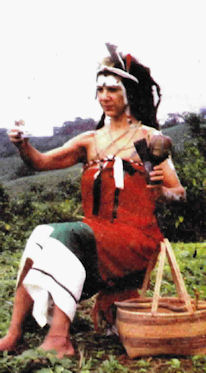|
Africa

From India, Leda and Jean-Noel decided to leave on a trip of exploration in Africa, to research group therapies, methods that often included the arts of dance and theatre. A long and difficult search led them to Gabon, where the Pigmies guard the age-old tradition of “Mombwiri” healing. 
It was there where she discovered that Bharata Natyam, as many ancient dances, is not only “the contemplation of the world in a state of grace” but also develops a strong form of energy, such as to bring audiences in a hypnotic trance, such as to enable Leda herself to dance on burning coals without getting hurt.
There, in the heart of Africa, she went through exacting initiation rites and for about two years she was taught methods that, although coming from so-called “primitive” societies, incorporate ideas and therapeutic approaches that only today Western science has begun to discover. A therapeutic framework based on living experience and which unfolds non-rationally, in a fantastic, mythological way.
Leda was the only Western researcher worldwide who was accepted by the Pigmy tribes to be taught this primeval dance therapy and healing form (More about this in the Travels section - for the moment being only in Greek - sorry!).
“The ritual art forms of India and Africa are not, in their essence, art forms. They are means of unblocking all tensions and energy which are blocked inside us. They are the expression of different sides of human being, with a goal to reach the essence, the core. I am ‘us’ until I become ‘I’”
Later on, wishing to give to this learning a Western scientific framework, she studied the American dance movement therapy system and took her degree with dr. Ìárcia B. Leventhal (of New York University). She is a member of the International Dance Movement Therapy Institute in Australia and the Dance Movement Therapists Union of Greece.
Travels
She has made extensive trips all over the world to explore different forms of dance, healing and symbolism. In the course of studying ancient theatrical art in ancient civilizations, she has also studied the significance, usage and techniques of masks, in many different countries and traditions:
• In Indonesia she studied the use of mask in the traditional “Topeng” temple theatre, with artist and teacher Babak I.Made Djlimat.
• In India she studied the use of mask in the Chhau art form of Seraikela (in Orissa), with L.R. Acharya and Shashidhar Acharya.
• In Sri Lanka she studied masked dances in relation to the healing of mental diseases.
• In Mexico she studied the traces of the ancient dances of the Mayas
• In Congo, Gabon, Cameroon and Dahomey (Central Africa), she studied the relationship of movement and dance with the expanding of inspiration, self-therapy and discovery of internal movement stability points as well as the usage of masks as related to the cult of the ancestors. During her trips in the Equatorial jungle, she collected authentic ritual masks -originally used for ancestor worship -, which she sometimes uses in her performances.
• In Papua-New Guinea
• In Cuba
• In Peru and the Amazon
In addition, she has participated for seven years in therapeutic sessions of humanistic psychotherapy in France.
She still travels a lot, everywhere in the world, searching for new sources of inspiration for an authentic and original artistic creation, beyond frontiers.
|


